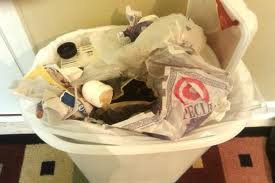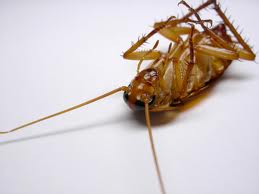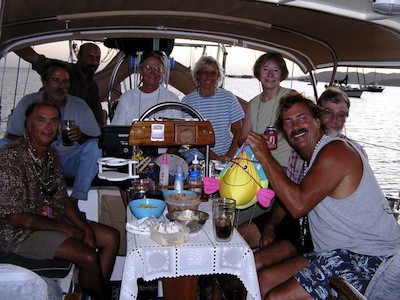NOT aboard Winterlude mind you (knock on teak), but a prevalent theme this fall returning to the boat is cockroaches. The docks are abuzz, the boatyard is abuzz. What’s UP? I HATE, despise, abhor and detest the little critters! I do not ever remember having one on board, despite being directly across the dock from a forlorn 60′ old abandoned literally half sinking Hatteras for two years at our marina. Thank goodness, that boat’s moved on but now there’s a boat just a few slips away that has cockroaches. 🙁 AND when we arrived in the boatyard and started talking to people, one of the first comments I heard was that a guy’s wife refused to ever step foot on the boat again because she spotted a cockroach.
Cockroaches typically become infested in boats after being brought aboard inadvertently in grocery bags, cardboard boxes, with laundry or wandering in from another infested locale close by — such as just down the dock. Once established, they multiply literally by the thousands and the problem can become almost overwhelming. That’s why it’s SO important not to allow them to become established.
Cockroaches love dark crevasses looking for food, warmth and moisture. Nocturnal creatures, they scurry about at night and hide during the daytime hours. They flourish where food and moisture are readily available. They are scavengers and will eat anything organic. They prefer food sources such as starches, sweets, grease and meat products, but other items may include cheese, beer, leather, glue, hair, starch in book bindings, flakes of dried skin or decaying organic matter (plant or animal).
 Sanitation is one of the most important steps in prevention and control. Empty soft drink bottles – rinse out any Coke cans or beer bottles before recycling or throwing them away, used glasses, food cans – anything that could have food, is rinsed thoroughly before being discarded. Do not allow trash to accumulate if possible — I know this can be a huge issue when cruising out of areas with established trash disposal, keeping it aboard makes it even MORE important to rinse everything before putting it in the trash. If you’re short on fresh water, rinse with salt water – and preferably allow to dry before discarding into the trash/recycle. Other tips:
Sanitation is one of the most important steps in prevention and control. Empty soft drink bottles – rinse out any Coke cans or beer bottles before recycling or throwing them away, used glasses, food cans – anything that could have food, is rinsed thoroughly before being discarded. Do not allow trash to accumulate if possible — I know this can be a huge issue when cruising out of areas with established trash disposal, keeping it aboard makes it even MORE important to rinse everything before putting it in the trash. If you’re short on fresh water, rinse with salt water – and preferably allow to dry before discarding into the trash/recycle. Other tips:
1. Do not leave dirty dishes in the sink and especially don’t let them remain there overnight.
2. Keep food scraps in the refrigerator or in containers with tight-fitting lids.
3. If you have a pet aboard, keep the pet food in tightly sealed containers, and do not allow food to remain in the bowls overnight.
4. Remove garbage regularly. Keep containers covered, especially at night.
5. A critical area is between the stove and cabinet, where grease and food scraps often accumulate. I know this is almost an impossible task, but clean between the stove and cabinet and behind the stove regularly!
Equally important is keeping cardboard boxes and paper bags off the boat. When we bring provisions back, the first step is to discard any cardboard packaging – usually on the dock before it even gets into the cockpit. It goes without saying that cardboard boxes or paper bags should not be allowed to accumulate aboard.
Food containers should be sealed and any crumbs or spillage cleaned up. When I inquired of the workmen working on the boat down the dock that told us the boat has cockroaches and they are getting ready to bomb it, I asked if they had any idea why or how the bugs got there. Apparently there were unrinsed empty soft drink cans and other food crumbs about — practically an invitation to a party for a cockroach!
Before leaving the boat, we always empty ALL food containers off the boat – the only thing left are canned goods. This includes partially open packages of pasta/flour/etc that are in heavy plastic containers in a side locker. The refrigerator and food storage areas are shut down, emptied and wiped out with a bleach solution. We are not fanatical about cleanliness, but we are especially careful when leaving the boat.
Where it gets a bit more tricky is if you only leave the boat for a short time – a couple of weeks for Thanksgiving family visits for instance. We still take many of the same measures, no open food containers, we do not shut down the freezer or refrigerator but make sure that anything that could spoil is off the boat, crumbs are cleaned up, trash is disposed of off the boat, etc.
When we leave the boat we use a combination of cockroach bait traps – we’re told online that Combat(R), Raid(R) Max Roach Bait, and Roach Ender(R) Roach Bait (Black Flag) are the most effective. These typically black plastic containers have holes for the bugs to crawl in, enjoy the bait which is a combination of food that attracts them laced with poison which they carry back to their lairs and share with their buddies and all of them die.
When outside the US and not able to get the bait traps, we used boric acid either mixed with a bit of coffee mate or not. We placed ours in empty bottle caps – although I’m told that it’s better to spread it around – not on counter surfaces, but in hidden areas. Key areas for treatment include under/behind the refrigerator areas, behind the stove, into the opening where plumbing pipes enter — under sinks and behind the head, under the shower grate, and into cracks along edges and corners inside cabinets and pantries. If you have hollow spaces under galley drawers or other food storage areas, these can become hiding places for cockroaches and offer good areas to sprinkle your boric acid dust.
 To be the most effective, they need to be placed strategically. Be sure to have most of the traps in the galley and a few in the head, and other food storage areas. Under sinks and heads/toilets, beneath refrigerators and stoves, next to trash containers and inside cabinets and food storage areas. Cockroaches travel usually in corners/edges, so place the bait traps flush in corners or against edges, where walls meet the floor inside a storage locker.
To be the most effective, they need to be placed strategically. Be sure to have most of the traps in the galley and a few in the head, and other food storage areas. Under sinks and heads/toilets, beneath refrigerators and stoves, next to trash containers and inside cabinets and food storage areas. Cockroaches travel usually in corners/edges, so place the bait traps flush in corners or against edges, where walls meet the floor inside a storage locker.
Placement of baits in the middle of exposed surfaces such as counter surfaces is usually not effective. Use a minimum of 12 bait stations should be used, placing 10 baits in the galley and two in the head. If cockroaches are seen in other areas such as storage lockers behind settees, use 2-4 additional baits.
It’s important not to spray around bait stations with other insecticides as this may keep them from feeding on the bait.
There are a variety of roach sprays, syringes and traps on the market – for a selection from Amazon, click here.
 Boats that have large infestations often use the bug bomb approach, close everything up, open all storage lockers, drawers, etc. set it off, leave the boat and come back hours later to clean literally everything inside – yuck, you have to wash all the dishes etc., but I understand they do work. I’d much rather avoid the problem in the first place!
Boats that have large infestations often use the bug bomb approach, close everything up, open all storage lockers, drawers, etc. set it off, leave the boat and come back hours later to clean literally everything inside – yuck, you have to wash all the dishes etc., but I understand they do work. I’d much rather avoid the problem in the first place!
Do you have any special measures or anything you think is particularly effective in combating roaches that I’ve forgotten? Please leave a comment and share the information! Cheers to NO ROACHES! Jan














I had the creepies after reading your article so I bought a box if the Raid baits today just in case!!!
Hope your bottom job is going smoothly!! How are all of your projects?
Hoping to get the sails on tomorrow!! Last coat of polyurethane went on last night, so we’ll be all moved in by the weekend!!
Hope to see you soon!!’
Dirty dishes attract roaches very much. If we leave the dirty dishes in out kitchen sink then cockroach will definitely come and take food from there. Actually we can prevent them from making nest into our house by keeping our dishes, sinks and kitchen dry and clean. Prevention is better than cure.
Unfortunately, if is bad enough that you have to bomb, you always have to do it a second time or the first time is ineffective. That is because the eggs are not killed by the first bomb. So you bomb to kill the live ones. Then you have to do it again after the incubation period and before they reach maturity. Like you said, prevention is best.